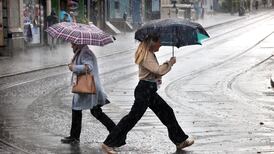It's a cliche that we never explore what is on our own doorsteps but we'll go museum-hopping and in search of the most offbeat cafes while on holiday and looking at places from an entirely different perspective. The question is, would you buy a guidebook to your own city and country? After all, most people travel with road maps in their car and - since glove-wearing while driving went out with Chitty Chitty Bang Bang - why not stick a couple of guidebooks in that redundant glove compartment this summer and rename it the bookshelf?
Time Out, the long-established London listings magazine, diversified into publishing city guidebooks some years ago. Having racked up guides to London, Prague, Sydney, San Francisco, Rome, and Berlin, as well as several other exotically-located cities, they have just published their first edition of the Time Out Guide To Dublin. We must have "arrived" somewhere in the world's consciousness.
Lonely Planet, meanwhile, has been with us ever since the word "hippy" entered the language and is still selling guidebooks to the more remote parts of the world by the rucksackful. The second edition of Lonely Planet Ireland was recently published, complete with deliberately uncliched cover of a brightly-painted yellow and orange cafe facade. This book, the cover picture seems to urge, does not contain the shamrock and shillelagh version of the emerald isle.
"I don't want to feel like a tourist in my own city"; "I'd prefer to discover things about Ireland for myself, instead of reading about it"; and "these sort of books are always out of date by the time they're published anyway" were among the comments made by people who saw these books lying around on the kitchen table over the course of a weekend.
Still, the sceptics picked them up and rifled through the pages just the same. Chief among the joys of looking at the Time Out Guide To Dublin was playing the game of "Name The Nameless People In The Photos". Almost every face was named effortlessly, and where monikers proved elusive, identification was still achieved by the simple method of: "Oh, that's your man/woman from (wherever), you always see them around."
Perhaps guidebooks to a native land are best treated like vitamin tablets: useful supplements to an existing diet. The reality is that nobody knows everything about their own city or country and both these books have lucky-dip type qualities. You can dip into either and never know what you're going to find out.
For instance, Time Out informs the reader that at Newbridge House at Donabate there is a Museum of Curiosities. Contents include: "Bricks from Babylon, a mummified head and an Indian dancing girl's plait." (It doesn't say if the plait and head belong to the same soul.) Lonely Planet tells you where you can find a 5,000-year-old partially submerged pine forest (Kilbaha); and the ironically-named seaside fish and chip shop, Baywatch (Killybegs).
It's difficult to imagine the Time Out Guide To Dublin could have been written even five years ago, when many of the places listed in this book did not exist and much of the city centre was being furiously remade. The book is divided into sections: Context; Dublin By Area; Sightseeing; Consumer; Arts and Entertainment; Trips Out of Town. The listings - restaurants, pubs, shops, accommodation, galleries etc - are excellent and extensive, as one would expect from a operation which originally built their reputation on a city listings magazine.
Many of the specialised features here are written by locals, among the writers are: Emma Donoghue (introduction); Luke Dodd (architecture); John McKenna (food); and David Wheatley (literature). The prose is consistently readable, sharp, unpretenious, and often funny, even when covering a topic as unpromising as department stores. On Guiney's: "The kind of shop where you can pick up a new suit, a duvet, a pair of Hush Puppies and a three-pack of Yfronts and still have change out of a fiver."
Compared to San Francisco, London or Sydney, Dublin is a much smaller city, and only has so much mileage. Despite the title, only about half of the Time Out Guide To Dublin covers Dublin - the rest goes by the slightly tongue-in-cheek description of "Trips out of Town". Unless travelling by helicopter or sevenleague boots, you'd hardly be day-tripping from Dublin to Dingle or the Aran islands.
Wicklow, Wexford, Waterford, Cork, Kerry, Clare, Galway, Donegal and Belfast are all covered in this book. As well as quirky and interesting introductions to each county, there's information on main attractions, accommodation, eating out, and festivals.
Lonely Planet Ireland employs its familiar, stalwart, no-nonsense style throughout. Although definitely a more bland read than Time Out, it's still much better-written and laid-out than most guidebooks about Ireland, and is more often hit than miss in its coverage.
There are several (fairly basic) city and county maps, and the dog-eared road atlases in your car come in useful as back-up. This is a book to take out and read before going somewhere new. Lonely Planet Ireland covers all 32 counties and the accommodation and eating-out listings envisage all budgets. As in Time Out, the index is excellent.
Occasionally, Lonely Planet shows its teeth, as in this extract from a piece on Joyce. "Ireland's attitude to Joyce has been a flagrant case of cultural expropriation, and the benign face that now graces the country's £10 note has been craftily doctored to present a kindly old gent, smiling indulgently. It conveys nothing of the man who always refused to change his British passport for an Irish one, or the angry young man who left Ireland in 1904, not to mention the author of a series of throughly pornographic letters to his wife." Hear hear.
Time Out Guide To Dublin is published by Penguin, price £9.99 in the UK. Lonely Planet Ireland is published by Lonely Planet, price £12.99 in the UK








